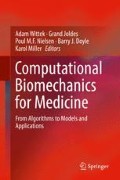Abstract
Noninvasive measurements of tissue deformation provide biomechanical insights of an organ, which can be used as clinical functional biomarkers or experimental data for validating computational simulations. However, acquisition of 3D displacement information is susceptible to experimental inconsistency and limited scan time. In this research, we describe the process of tracking tagged magnetic resonance imaging (MRI) as enforcing harmonic phase conservation in finite-element (FE) models. This concept is demonstrated as a tool for motion estimation in an experimental brain phantom, and images from the human heart and tongue. Our results demonstrate that the new methodology offers robustness to edge and large-displacement artifacts, and that it can be seamlessly coupled with numerical simulations for estimating fiber stretch in residually stressed tissue, or for inverse identification of muscle activation.
Access this chapter
Tax calculation will be finalised at checkout
Purchases are for personal use only
References
Phatak NS, Maas SA, Veress AI, Pack NA, Di Bella EVR, Weiss JA (2009) Strain measurement in the left ventricle during systole with deformable image registration. Med Image Anal 13:354–361
Wright RM, Ramesh KT (2012) An axonal strain injury criterion for traumatic brain injury. Biomech Model Mechanobiol 11:245–260
Haber I, Metaxas DN, Axel L (2000) Three-dimensional motion reconstruction and analysis of the right ventricle using tagged MRI. Med Image Anal 4:335–355
Ibrahim E-SH (2011) Myocardial tagging by cardiovascular magnetic resonance: evolution of techniques-pulse sequences, analysis algorithms, and applications. J Cardiovasc Magn Reson 13:36
Bayly PV, Clayton EH, Genin GM (2012) Quantitative imaging methods for the development and validation of brain biomechanics models. Annu Rev Biomed Eng 14:369–396
Moerman KM, Sprengers AMJ, Simms CK, Lamerichs RM, Stoker J, Nederveen AJ (2012) Validation of tagged MRI for the measurement of dynamic 3D skeletal muscle tissue deformation. Med Phys 39:1793–1810
Harandi, N.M., Woo, J., Farazi, M.R., Stavness, L., Stone, M., Fels, S., Abugharbieh, R. (2015) Subject-specific biomechanical modelling of the oropharynx with application to speech production. IEEE ISBI, pp 1389–1392
Knutsen AK, Magrath E, McEntee JE, Xing F, Prince JL, Bayly PV, Butman JA, Pham DL (2014) Improved measurement of brain deformation during mild head acceleration using a novel tagged MRI sequence. J Biomech 47:3475–3481
Spottiswoode BS, Zhong X, Hess AT, Kramer CM, Meintjes EM, Mayosi BM, Epstein FH (2007) Tracking myocardial motion from cine DENSE images using spatiotemporal phase unwrapping and temporal fitting. IEEE Trans Med Imaging 26:15–30
Liu X, Abd-Elmoniem KZ, Stone M, Murano EZ, Zhuo J, Gullapalli RP, Prince JL (2012) Incompressible deformation estimation algorithm (IDEA) from tagged MR images. IEEE Trans Med Imaging 31:326–340
Osman NF, McVeigh ER, Prince JL (2000) Imaging heart motion using harmonic phase MRI. IEEE Trans Med Imaging 19:186–202
Horn, B.K., Schunck, B.G. (1981) Determining optical flow. In: Technical Eymposium East. pp. 319–331
Bonet J, Wood RD (1997) Nonlinear continuum mechanics for finite element analysis. Cambridge University Press, Cambridge
Bathe KJ (1996) Finite element procedures. Prentice-Hall, Upper Saddle River
Maas SA, Ellis BJ, Ateshian GA, Weiss JA (2012) FEBio: finite elements for biomechanics. J Biomech Eng 134(1):011005
Spencer AJM (1985) Continuum mechanics. Dover Books, Essex
Guo H, Nickel JC, Iwasaki LR, Spilker RL (2012) An augmented Lagrangian method for sliding contact of soft tissue. J Biomech Eng 134:084503
Genet M, Rausch MK, Lee LC, Choy S, Zhao X, Kassab GS, Kozerke S, Guccione JM, Kuhl E (2015) Heterogeneous growth-induced prestrain in the heart. J Biomech 48:2080–2089
Ateshian GA, Ricken T (2010) Multigenerational interstitial growth of biological tissues. Biomech Model Mechanobiol 9:689–702
Acknowledgments
This research was funded by NIH Grant R01-NS055951, supplement PA12-149, and support by the Center for Neuroscience and Regenerative Medicine.
Author information
Authors and Affiliations
Corresponding author
Editor information
Editors and Affiliations
Rights and permissions
Copyright information
© 2017 Springer International Publishing AG
About this paper
Cite this paper
Gomez, A.D., Xing, F., Chan, D., Pham, D.L., Bayly, P., Prince, J.L. (2017). Motion Estimation with Finite-Element Biomechanical Models and Tracking Constraints from Tagged MRI. In: Wittek, A., Joldes, G., Nielsen, P., Doyle, B., Miller, K. (eds) Computational Biomechanics for Medicine. Springer, Cham. https://doi.org/10.1007/978-3-319-54481-6_7
Download citation
DOI: https://doi.org/10.1007/978-3-319-54481-6_7
Published:
Publisher Name: Springer, Cham
Print ISBN: 978-3-319-54480-9
Online ISBN: 978-3-319-54481-6
eBook Packages: EngineeringEngineering (R0)

